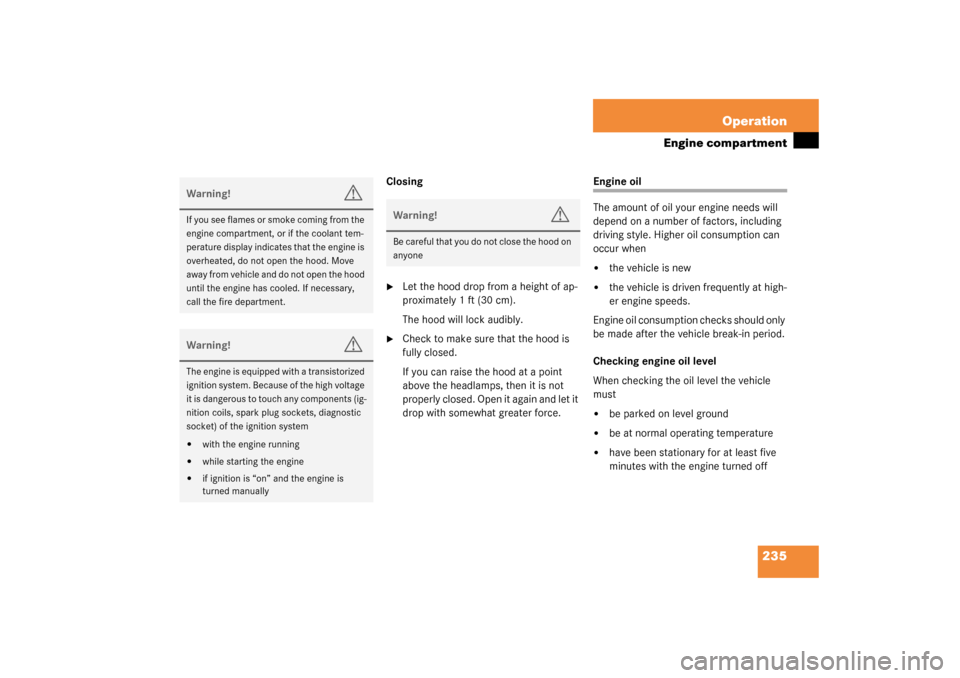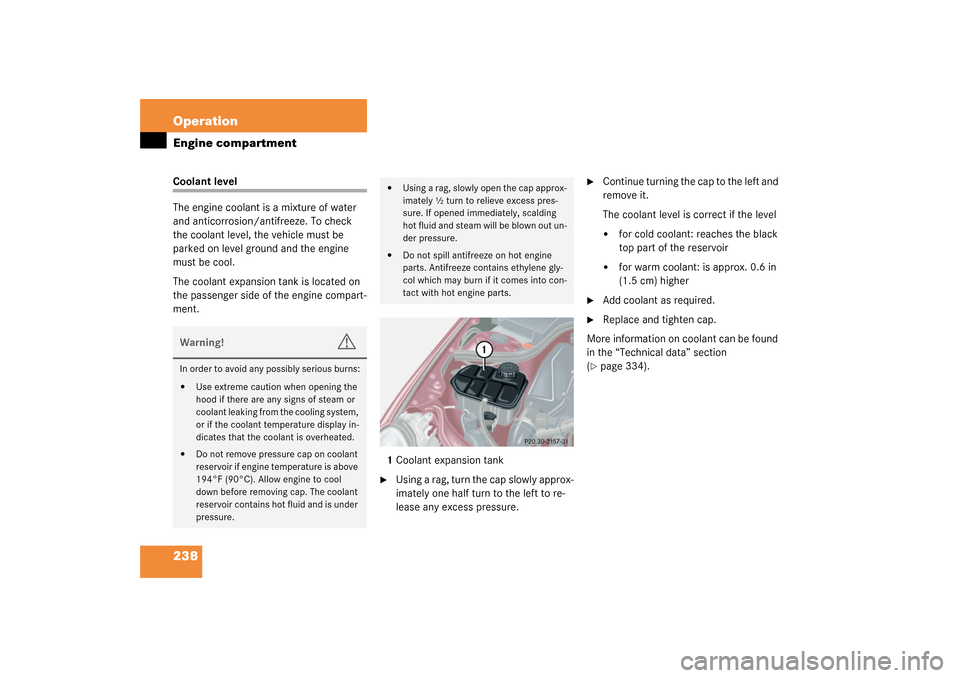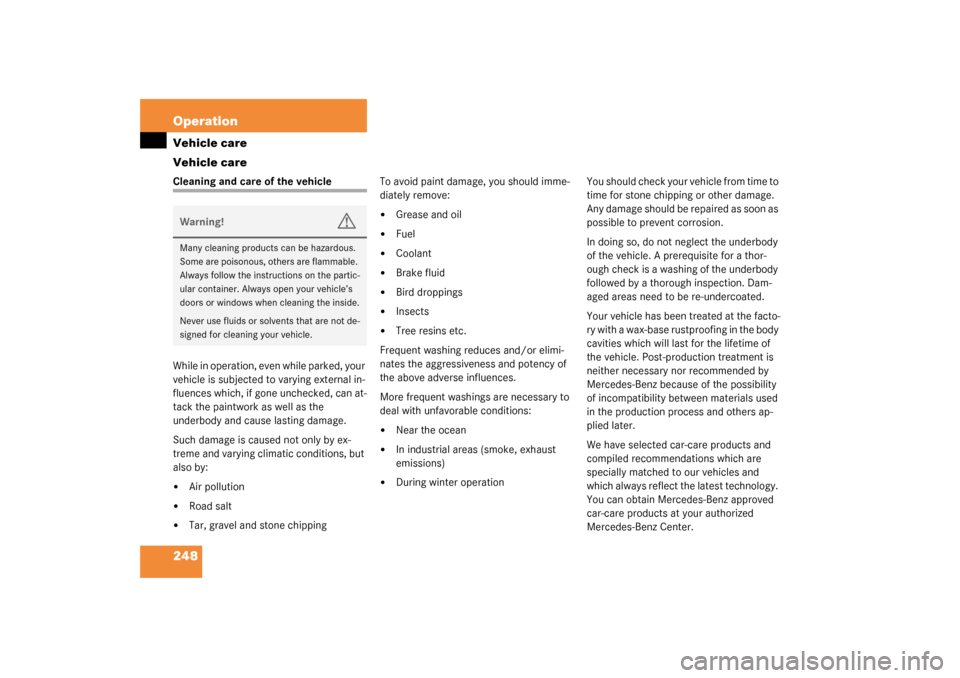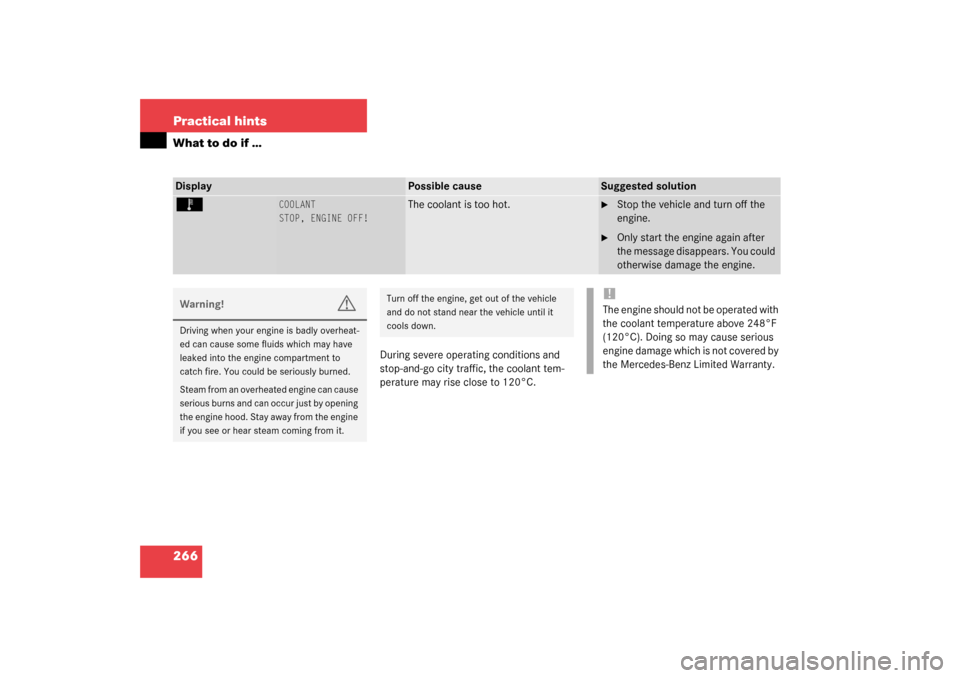Page 229 of 370

235 Operation
Engine compartment
Closing�
Let the hood drop from a height of ap-
proximately 1ft (30cm).
The hood will lock audibly.
�
Check to make sure that the hood is
fully closed.
If you can raise the hood at a point
above the headlamps, then it is not
properly closed. Open it again and let it
drop with somewhat greater force.
Engine oil
The amount of oil your engine needs will
depend on a number of factors, including
driving style. Higher oil consumption can
occur when �
the vehicle is new
�
the vehicle is driven frequently at high-
er engine speeds.
Engine oil consumption checks should only
be made after the vehicle break-in period.
Checking engine oil level
When checking the oil level the vehicle
must
�
be parked on level ground
�
be at normal operating temperature
�
have been stationary for at least five
minutes with the engine turned off
Warning!
G
If you see flames or smoke coming from the
engine compartment, or if the coolant tem-
perature display indicates that the engine is
overheated, do not open the hood. Move
away from vehicle and do not open the hood
until the engine has cooled. If necessary,
call the fire department.Warning!
G
The engine is equipped with a transistorized
ignition system. Because of the high voltage
it is dangerous to touch any components (ig-
nition coils, spark plug sockets, diagnostic
socket) of the ignition system�
with the engine running
�
while starting the engine
�
if ignition is “on” and the engine is
turned manually
Warning!
G
Be careful that you do not close the hood on
anyone
S203 MY03_A.book Page 235 Tuesday, January 28, 2003 2:22 PM
Page 232 of 370

238 OperationEngine compartmentCoolant level
The engine coolant is a mixture of water
and anticorrosion/antifreeze. To check
the coolant level, the vehicle must be
parked on level ground and the engine
must be cool.
The coolant expansion tank is located on
the passenger side of the engine compart-
ment.
1Coolant expansion tank
�
Using a rag, turn the cap slowly approx-
imately one half turn to the left to re-
lease any excess pressure.
�
Continue turning the cap to the left and
remove it.
The coolant level is correct if the level �
for cold coolant: reaches the black
top part of the reservoir
�
for warm coolant: is approx. 0.6 in
(1.5 cm) higher
�
Add coolant as required.
�
Replace and tighten cap.
More information on coolant can be found
in the “Technical data” section
(
�page 334).
Warning!
G
In order to avoid any possibly serious burns:�
Use extreme caution when opening the
hood if there are any signs of steam or
coolant leaking from the cooling system,
or if the coolant temperature display in-
dicates that the coolant is overheated.
�
Do not remove pressure cap on coolant
reservoir if engine temperature is above
194°F (90°C). Allow engine to cool
down before removing cap. The coolant
reservoir contains hot fluid and is under
pressure.
�
Using a rag, slowly open the cap approx-
imately ½ turn to relieve excess pres-
sure. If opened immediately, scalding
hot fluid and steam will be blown out un-
der pressure.
�
Do not spill antifreeze on hot engine
parts. Antifreeze contains ethylene gly-
col which may burn if it comes into con-
tact with hot engine parts.
S203 MY03_A.book Page 238 Tuesday, January 28, 2003 2:22 PM
Page 242 of 370

248 OperationVehicle care
Vehicle careCleaning and care of the vehicle
While in operation, even while parked, your
vehicle is subjected to varying external in-
fluences which, if gone unchecked, can at-
tack the paintwork as well as the
underbody and cause lasting damage.
Such damage is caused not only by ex-
treme and varying climatic conditions, but
also by:�
Air pollution
�
Road salt
�
Tar, gravel and stone chippingTo avoid paint damage, you should imme-
diately remove:
�
Grease and oil
�
Fuel
�
Coolant
�
Brake fluid
�
Bird droppings
�
Insects
�
Tree resins etc.
Frequent washing reduces and/or elimi-
nates the aggressiveness and potency of
the above adverse influences.
More frequent washings are necessary to
deal with unfavorable conditions:
�
Near the ocean
�
In industrial areas (smoke, exhaust
emissions)
�
During winter operationYou should check your vehicle from time to
time for stone chipping or other damage.
Any damage should be repaired as soon as
possible to prevent corrosion.
In doing so, do not neglect the underbody
of the vehicle. A prerequisite for a thor-
ough check is a washing of the underbody
followed by a thorough inspection. Dam-
aged areas need to be re-undercoated.
Your vehicle has been treated at the facto-
ry with a wax-base rustproofing in the body
cavities which will last for the lifetime of
the vehicle. Post-production treatment is
neither necessary nor recommended by
Mercedes-Benz because of the possibility
of incompatibility between materials used
in the production process and others ap-
plied later.
We have selected car-care products and
compiled recommendations which are
specially matched to our vehicles and
which always reflect the latest technology.
You can obtain Mercedes-Benz approved
car-care products at your authorized
Mercedes-Benz Center.
Warning!
G
Many cleaning products can be hazardous.
Some are poisonous, others are flammable.
Always follow the instructions on the partic-
ular container. Always open your vehicle’s
doors or windows when cleaning the inside.
Never use fluids or solvents that are not de-
signed for cleaning your vehicle.
S203 MY03_A.book Page 248 Tuesday, January 28, 2003 2:22 PM
Page 259 of 370
265 Practical hints
What to do if …
Display
Possible cause
Suggested solution
B
COOLANT
CHECK LEVEL!
The coolant level is too low.
�
Add coolant (
�page 238).
�
If you have to add coolant frequent-
ly, have the cooling system
checked by an authorized
Mercedes-Benz Center.
Warning!
G
Do not spill antifreeze on hot engine parts.
Antifreeze contains ethylene glycol which
may burn if it comes into contact with hot
engine parts. You can be seriously burned.
!Do not ignore the low engine coolant
level warning. Extended driving with
the message and symbol displayed
may cause serious engine damage not
covered by the Mercedes-Benz Limited
Warranty.
Do not drive without sufficient amount
of coolant in the cooling system. The
engine will overheat, causing major en-
gine damage.
S203 MY03_A.book Page 265 Tuesday, January 28, 2003 2:22 PM
Page 260 of 370

266 Practical hintsWhat to do if …
During severe operating conditions and
stop-and-go city traffic, the coolant tem-
perature may rise close to 120°C.
Display
Possible cause
Suggested solution
Ï
COOLANT
STOP, ENGINE OFF!
The coolant is too hot.
�
Stop the vehicle and turn off the
engine.
�
Only start the engine again after
the message disappears. You could
otherwise damage the engine.
Warning!
G
Driving when your engine is badly overheat-
ed can cause some fluids which may have
leaked into the engine compartment to
catch fire. You could be seriously burned.
Steam from an overheated engine can cause
serious burns and can occur just by opening
the engine hood. Stay away from the engine
if you see or hear steam coming from it.
Turn off the engine, get out of the vehicle
and do not stand near the vehicle until it
cools down.
!The engine should not be operated with
the coolant temperature above 248°F
(120°C). Doing so may cause serious
engine damage which is not covered by
the Mercedes-Benz Limited Warranty.
S203 MY03_A.book Page 266 Tuesday, January 28, 2003 2:22 PM
Page 261 of 370
267 Practical hints
What to do if …
Display
Possible cause
Suggested solution
Ï
COOLANT
STOP, ENGINE OFF!
The poly-V-belt could be broken.
�
Stop immediately and check the
poly-V-belt.
If it is broken:
�
Do not continue to drive. Otherwise
the engine will overheat due to an
inoperative water pump which may
result in damage to the engine. No-
tify an authorized Mercedes-Benz
Center.
If it is intact:
�
Do not continue to drive the vehicle
with this message displayed. Doing
so could result in serious engine
damage that is not covered by the
Mercedes-Benz Limited Warranty.
COOLANT
VISIT WORKSHOP!
The cooling fan for the coolant is mal-
functioning.
�
Observe the coolant temperature
display.
�
Have the fan replaced as soon as
possible.
S203 MY03_A.book Page 267 Tuesday, January 28, 2003 2:22 PM
Page 272 of 370

278 Practical hintsWhat to do if …Display
Possible cause
Suggested solution
#
UNDERVOLTAGE
ENGINE ON!
The battery has insufficient voltage and
can no longer supply the convenience
functions such as seat heater*.
�
Start the engine (
�page 44).
UNDERVOLTAGE
SWITCH CONSUMERS OFF!
The battery is malfunctioning.
�
Have the battery checked at a ser-
vice station.
G
VISIT WORKSHOP!
DISPLAY DEFECTIVE
The instrument cluster display is mal-
functioning.
�
Continue driving with added cau-
tion.
�
Visit an authorized Mercedes-Benz
Center as soon as possible.
±
VISIT WORKSHOP!
DISPLAY DEFECTIVE
Certain electronic systems are unable to
relay information to the control system.
The following systems may have failed:�
Coolant temperature display
�
Tachometer
�
Cruise control display
�
Have the electronic systems
checked by an authorized
Mercedes-Benz Center
(�page 258).
W
WASHER FLUID
CHECK LEVEL!
The fluid level has dropped to about
1/3
of total reservoir capacity.�
Add washer fluid (
�page 240).
S203 MY03_A.book Page 278 Tuesday, January 28, 2003 2:22 PM
Page 311 of 370
317 Technical data
Spare parts service
Warranty coverage
Identification labels
Layout of poly-V-belt drive
Engine
Rims and Tires
Electrical system
Main Dimensions
Weights
Fuels, coolants, lubricants etc.
Consumer information
S203 MY03_A.book Page 317 Tuesday, January 28, 2003 2:22 PM